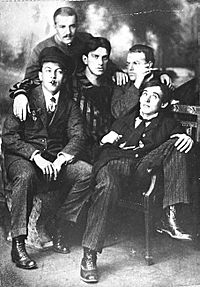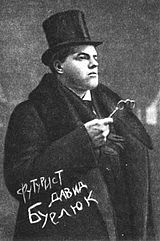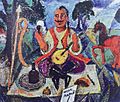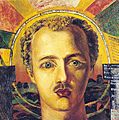David Burliuk facts for kids
Quick facts for kids
David Burliuk
|
|
|---|---|
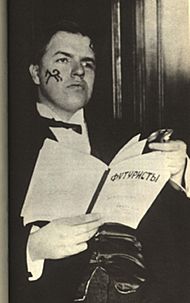
Burliuk in 1914, aged 32
|
|
| Born | David Davidovich Burliuk 21 July 1882 Riabushky, Russian Empire (now Lebedyn District, Sumy Oblast, Ukraine) |
| Died | 15 January 1967 (aged 84) Long Island, New York |
| Nationality | Ukrainian |
| Literary movement | Russian Futurism |
David Davidovich Burliuk (Russian and Ukrainian: Дави́д Дави́дович Бурлю́к; born July 21, 1882 – died January 15, 1967) was an important Ukrainian and Russian artist and poet. He was known for his work with the Futurist art movement. Many people call him "the father of Russian Futurism" because he helped start this exciting new style of art.
Contents
About David Burliuk
His Early Life
David Burliuk was born in 1882 in a village called Riabushky, which is now in Ukraine. His family had roots in Ukrainian Cossacks, who were brave warriors. His mother, Ludmyla Mikhnevich, was from Belarus.
His Art and Career
From 1898 to 1904, David studied art in different cities like Kazan, Odessa, and Munich. His teachers noticed his lively and energetic personality. One professor even called him a "wonderful wild steppe horse."
In 1907, he started connecting with other artists in Russia. He became good friends with Mikhail Larionov. Together, they played a big part in bringing new art ideas to Russia. In 1908, David helped organize an art show in Kiev with a group called Zveno ("The Link"). This first show wasn't very successful because the artists were not well known yet.
Later, David and his brother Wladimir went to their home in Chernianka. There, their art became more avant-garde, which means it was very new and experimental. They even held an art show on the street, which was a big success! It helped them earn enough money to go to Moscow.
In 1909, Burliuk painted a portrait of his future wife, Marussia. He often painted her throughout his life. He also loved to paint his homeland, first Ukraine and then the United States, where he later lived.
The Futurists
In 1910, David Burliuk and his brothers started a group called Hylaea. This group became the beginning of Cubo-Futurism, which was a very important art movement in Russia. Other famous poets like Vladimir Mayakovsky and Velimir Khlebnikov joined them.
The Cubo-Futurists loved to shock people. They would wear strange clothes, paint their faces, and perform plays that were hard to understand. They even had fights with the audience at their poetry readings! One famous play was Victory over the Sun, about destroying old ways of thinking.
In 1913, David Burliuk and Mayakovsky were even kicked out of their art academy because of their rebellious ideas. But they kept going! In 1912, David was one of the writers of an important paper called A Slap in the Face of Public Taste. This paper explained the ideas of Russian Futurism.
From 1910, David was also part of another art group called Jack of Diamonds. He continued to study art and write about it. In 1913, he took part in a famous art show in Munich called the Blaue Reiter, which means "Blue Rider."
During World War I, in 1916, David's brother Wladimir was sent to fight and was sadly killed in 1917. After the war, David left Russia and traveled through Siberia, Japan, and Canada before settling in the United States in 1922. Even though he didn't know English at first, he made friends with American artists and became well-known there.
In New York City, Burliuk continued to be active in art. He wanted to be known as the "father of Russian Futurism" in his new home. He often wrote for a Russian newspaper and published his own books and magazines with his wife, Maria Nikiforovna.
In 1925, Burliuk helped start the Association of Revolutionary Masters of Ukraine (ARMU). He also showed his art in big exhibitions, including one in 1927 in Leningrad (now St. Petersburg) with other famous artists like Kazimir Malevich.
Later Years
In the 1930s, a collector named Onya La Tour bought many of Burliuk's artworks.
David Burliuk wanted to visit his homeland, the Soviet Union, in 1940. He even offered to give them a large collection of his friend Vladimir Mayakovsky's works and over 100 of his own paintings. But his requests were turned down. He was only allowed to visit Russia much later, in 1956 and 1965.
In 1962, David and his wife traveled to Australia and held an art show there. From 1937 to 1966, they published a journal called Color & Rhyme, which mostly shared news about Burliuk's art and life.
David Burliuk lived in Hampton Bays on Long Island, New York, for about 20 years until he passed away in 1967. His house and art studio are still there today.
His Legacy
In the world of Russian poetry, David Burliuk is seen as a true pioneer. In 1990, a special award called the David Burliuk Prize was created for new and experimental poetry.
Fun Facts
- Burliuk is mentioned in a famous poem by Vladimir Mayakovsky called A Cloud in Trousers (1915).
- A painting by Burliuk (which is probably made up for the story) appears in the novel Chapayev and Void by Victor Pelevin. The painting is described as a black word "GOD" written through a stencil.
Gallery
Books and Writings
- 1912: He helped write the Russian Futurist manifesto A Slap in the Face of Public Taste.
- 1915: He published the book The Support of the Muses in Spring.
Images for kids
See also
 In Spanish: David Burliuk para niños
In Spanish: David Burliuk para niños


